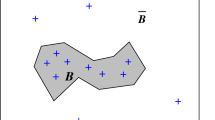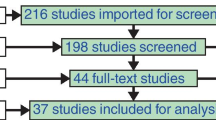Abstract
Favorability methods produce a unique measure for mineral potential mapping and quantitative estimation of mineral resources. Indicator favorability theory is developed in this study to account for spatial (auto and cross) correlations of regionalized geological, geochemical, and geophysical fields based on the indicator concept. Target and explanatory indicators are introduced to describe, respectively, direct and indirect evidence of the mineralization of interest. Mineralization is represented by a combination (Θ) of a set of target indicators. Indicator favorability theory estimates a regionalized favorability function in two stages: (1) estimate a linear combination of target indicators by maximizing var(Θ) and (2) estimate favorability functionF by minimizing estimation variance var[F−Θ]. The model is established on the basis of a conceptual model of target. The favorability estimates can be justified by correlation analysis and cross validation in control areas. The indicator favorability theory is demonstrated on a case study for gold-silver mineral potential mapping based on geophysical, structural, and geochemical fields.
Similar content being viewed by others
References
Agterberg, F.P., 1989, Computer programs for mineral exploration: Science, v. 245, p. 76–81.
—, 1992, Combining indicator patterns in weights of evidence modeling for resource evaluation: Nonrenewable Resources, v. 1, p. 39–50.
Agterberg, F.P., Bonham-Carter, G.F., and Wright, D.F., 1990, Statistical pattern integration for mineral exploration,in Gaál, G., and Merriam, D.F., eds., Computer applications in resource exploration, prediction, and assessment for metals and petroleum. Oxford, Pergamon, p. 1–21.
Bonham-Carter, G.F., Agterberg, F.P., and Wright, D.F., 1988, Integration of geological datasets for gold exploration in Nova Scotia: Photogrammetry and Remote Sensing, v. 54, p. 1585–1592.
Bonham-Carter, G.F., Reddy, R.K.T., and Galley, A.G., 1990, Preliminary results using a forward-chaining inference net with a GIS to map base-metal potential-Application to Snow Lake greenstone belt, Manitoba, Canada: Proc. of Intern. Workshop on Statistical Prediction of Mineral Resources, Wuhan, China, Oct. 20–25, 1990, v. 1.
Botbol, J.M., Sinding-Larsen, R., McCammon, R.B., and Gott, G.B., 1978, A regionalized multivariate approach to target selection in geochemical exploration: Economic Geology, v. 73, p. 534–546.
Chung, C.F., and Fabbri, A.G., 1993, The representation of geoscience information for data integration: Nonrenewable Resources, v. 2, p. 122–139.
Clark, I., Basinger, K.L., and Harper, W.V., 1989, MUCK—A novel approach to cokriging,in Buxton, B.E., Proceedings of the Conference on Geostatistical, Sensitivity, and Uncertainty Methods for Ground-Water Flow and Radionuclide Transport Modeling: Battelle Press, p. 473–493.
David, M., 1977, Geostatistical ore reserve estimation: New York, Elsevier, 364 p.
Fraser, D.C., 1978, Resistivity mapping with an airborne multicoil electromagnetic system: Geophysics, v. 43, p. 144–172.
Fraser, D.C., 1990, Layered-earth resistivity mapping: U.S. Geological Survey Bulletin, p. 33–41.
Harris, D.P., 1984, Mineral resources appraisal: London, Oxford Univ. Press, 445 p.
Journel, A.G., 1983, Nonparametric estimation of spatial distributions: Mathematical Geology, v. 15, p. 445–468.
Journel, A.G., and Huijbregts, C.J., 1978. Mining geostatistics: London, Academic Press, 600 p.
Kalbfleisch, J.G., 1985, Probability and statistical inference: New York, Springer-Verlag, 360 p.
Laznicka, P., 1983, Giant ore deposits—A quantitative approach: Global Tectonics and Metallogeny, v. 2, p. 41–63.
McCammon, R.B., Botbol, J.M., Sinding-Larsen, R., and Bowen, R.W., 1983, Characteristic analysis, 1981—Final program and a possible discovery: Mathematical Geology, v. 15, p. 59–83.
McCammon, R.B., and Kork, J.O., 1992, One-level prediction—A numerical method for estimating undiscovered metal: Nonrenewable Resources, v. 1, p. 139–147.
Myers, D.E., 1982, Matrix formulation of co-kriging: Mathematical Geology, v. 14, p. 249–257.
—, 1983, Estimation of linear combinations and co-kriging: Mathematical Geology, v. 15, p. 633–637.
—, 1988, Multivariate geostatistics for environmental monitoring: Sciences de la Terre, v. 27, p. 411–428.
—, 1991, Pseudocross-variograms, positive definiteness and cokriging: Mathematical Geology, v. 23, p. 805–816.
Pan, G.C., 1989, Concepts and methods of multivariate information synthesis for mineral resources estimation: Tucson, University of Arizona, Ph.D. dissertation, 302 p.
Pan, G.C., 1992, Regionalized favorability theory for information synthesis in mineral exploration: Mathematical Geology, v. 25.
Pan, G.C., and Harris, D.P., 1990, Three nonparametric techniques for optimum discretization of quantitative geological measurements: Mathematical Geology, v. 22, p. 699–722.
—, 1992a, Decomposed and weighted characteristic analysis for the quantitative estimation of mineral resources: Mathematical Geology, v. 24, p. 807–823.
—, 1992b, Estimating a favorability equation for the integration of geodata and selection of mineral exploration targets: Mathematical Geology, v. 24, p. 177–202.
Pan, G.C., 1992c, The related information approach to the integration of diverse geological data and mineral resources estimation,in Kim, Y.C., ed., Proc. 23rd Application of Computers and Operations Research in the Mineral Industry: Tucson, Arizona, April 7–11, 1992, p. 969–979.
Pan, G.C., Moss, K., Heiner, T., and Carr, J.R., 1992, A FORTRAN program for three-dimensional cokriging with case demonstration: Computers and Geosciences, v. 18, p. 557–578.
Pan, G.C., and Wang, Y., 1987, Weighted characteristic analysis and its application to quantitative estimation of pegmatitic Nb-Ta mineral resources: Geol. and Prospect., v. 23, p. 34–42. [In Chinese]
Reddy, R.K.T., Bonham-Carter, G.F., and Galley, A.G., 1992, Developing a geographic expert system for regional mapping of volcanogenic massive sulfide (VMS) deposit potential: Nonrenewable Resources, v. 1, p. 112–124.
Author information
Authors and Affiliations
Rights and permissions
About this article
Cite this article
Pan, G. Indicator favorability theory for mineral potential mapping. Nat Resour Res 2, 292–311 (1993). https://doi.org/10.1007/BF02257540
Received:
Revised:
Accepted:
Issue Date:
DOI: https://doi.org/10.1007/BF02257540




